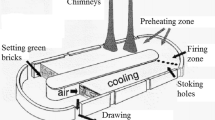A mathematical description of an industrial heavy residue thermolysis reactor is provided based on laboratory investigations and mathematical processing of experimental data. The optimum option for mechanization and implementation of the heavy oil residue thermolysis process is chosen for designing on the example of thermolysis of heavy residue of a specific oil. The mathematical model can be used for executing the process in an industrial reactor for getting oil agglutinating additive of the desired quality. Economic calculations showed the possibility of increasing marginal profits of the company.





Similar content being viewed by others
References
I.R. Khairutdinov, A.N. Morozov, and B.S. Zhirnov, Neftepererab. Neftekhim., No. 11, 8-11 (2006).
A.N. Morozov, I.R. Khairutdinov, and B.S. Zhirnov, et al., Neftepererab. Nefetkhim., No. 12, 15-19 (2006).
I.M. Glushchenko and O.F. Dolgikh, Khim. Tv. Topl., No. 1, 63-69 (1990).
“Promising areas of improvement and optimization of heavy resid thermal polycondensation,” Mir Nefteproduktov, No. 11, 15-19 (2011).
A.I. Olfert, Koks i Khimiya, No. 6, 12-16 (1988).
R.N. Gimaev, Theoretical Foundations of Technical Carbon Production from Petroleum Stock [in Russian], Doctoral dissertation, Ufa Petroleum Institute, Ufa (1776).
M.A. Gusev, Yu.B. Amerik, M.A. Anisimov, et al., Khim. Tekhnol. Topl. Masel, No. 5, 30-32 (1985).
D.F. Varfolomeev, Prospects of Production and Use of Oil Agglutinating Additive (OAA) for Producing Metallurgical Coke from Charges with High Content of Low- and Non-Coking Coals [in Russian], TsNIITEneftekhim, Moscow (1990), p. 40.
V.M. Bairamov, Foundations of Chemical Kinetics and Catalysis [in Russian], Akademiya, Moscow (2003), p. 256.
N.M. Emanuel and D.G. Knorre, A Course on Chemical Kinetics [in Russian], Vysshaya Shkola, Moscow (1974), p. 463.
I.R. Khairutdinov, R.Kh. Sadykov, N.S. Gaskarov, et al., “Options of industrial production of oil agglutinating additives: Problems of thorough oil refining,” in: Collec. of Papers of BashNIINP [In Russian], 37-49 (1992).
B.S. Zhirnov, A.N. Morozov, A.S. Alyabyev, et al., Production of Petroleum Pitches and Petroleum Agglutinating Additives from Heavy Oil Residues [in Russian], Izd. Press-tsentr OAO Salavatnefteorgsintez, Salavat (2010), p. 38.
M.R. Fatkullin, V.V, Zapylkina, A.N. Morozov, et al., Neftepererab. Nefetkhim., No. 11, 31-36 (2011).
G.G. Valyavin, V.V. Fryazinov, R.N. Gimaev, et al., Khim. Tekhnol. Topl. Masel, No. 8, 8-11 (1979).
Author information
Authors and Affiliations
Corresponding author
Additional information
Translated from Khimiya i Tekhnologiya Topliv i Masel, No. 3, pp. 40–42 May–June, 2022.
Rights and permissions
Springer Nature or its licensor holds exclusive rights to this article under a publishing agreement with the author(s) or other rightsholder(s); author self-archiving of the accepted manuscript version of this article is solely governed by the terms of such publishing agreement and applicable law.
About this article
Cite this article
Zhirnov, B.S., Fatkullin, M.R. & Luneva, N.N. Mathematical Modeling of Heavy Oil Residue Thermolysis Process Reactor. Chem Technol Fuels Oils 58, 465–468 (2022). https://doi.org/10.1007/s10553-022-01407-2
Published:
Issue Date:
DOI: https://doi.org/10.1007/s10553-022-01407-2




